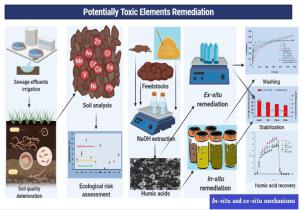Environmental Technology & Innovation ( IF 6.7 ) Pub Date : 2021-05-10 , DOI: 10.1016/j.eti.2021.101599 Ahmed Mosa , Ahmed A. Taha , Marwa Elsaeid

|
The complicated reactions among elemental pollutants and humic substances (HS) in soil matrix are not fully understood. Herein, natural humic acid (HA) was evaluated for its foreseeable in-situ and ex-situ remediation effects on a Typic Torripsamment soil subjected to long-term irrigation with sewage effluents. Humic acid was extracted from Vertic Torrifluvents soil (HA), farmyard manure (HA) and wheat straw (HA). Physicochemical analyses illustrated the higher surface reactivity of HA compared to other types. Ecological risk assessment indices showed hazardous soil contamination due to the cumulative impact of potentially toxic elements (PTEs). The extractability of PTEs showed variations in HA-amended treatments. Mobile and/or available fractions of some PTEs (As, Cd, Mn, Ni, Pb and Zn) showed higher extractability compared to the unamended treatment suggesting the potentiality of HA to serve as a washing agent. Other PTEs (Cr, Fe and V) showed less extractability suggesting the immobilization effect of HA. The ex-situ kinetic removal of aqueous PTEs increased sharply, peaked at 240 min, and reached equilibrium at 48 h. HA showed higher in-situ and ex-situ remediation efficiency compared to other types given the uniqueness of its surface reactivity.Derjaguin–Landau–Verwey–Overbeek (DLVO) theory well-interpreted the behavior of HA transport in sand column, and the actual mobility fitted well with Advection–dispersion–reaction (ADR) model. Attachment of HA onto sand beads occurred via secondary energy minimum, and the mass balance calculations showed recovery values of about 56.7, 48.9 and 44.7% for HA, HA and HA, respectively. In essence, data of this research provide insights for understanding combined washing-stabilization mechanisms involved in PTEs remediation by HA amendments.
中文翻译:

从不同原料中提取的腐殖酸原位和异位修复潜在的有毒元素:经过长期污水灌溉的污染土壤的实验观察
土壤基质中的元素污染物和腐殖质(HS)之间的复杂反应还不完全清楚。这里,天然腐殖酸(HA)为它的可预见的评价 原位 和 易地 上的修复效果 Typic Torripsamment 经受长期灌溉与下水道污水土壤。腐殖酸是从 Vertic Torrifluvents土壤(HA),农家肥料(HA)和麦草(HA)。理化分析表明HA的表面活性较高与其他类型相比。生态风险评估指数显示,由于潜在有毒元素(PTE)的累积影响,土壤有害污染。PTE的可萃取性在HA改良的处理方法中显示出差异。与未经修正的处理方法相比,某些PTE(如As,Cd,Mn,Ni,Pb和Zn)的可移动和/或可利用馏分显示出更高的可萃取性,表明HA可能具有作为清洗剂的潜力。其他PTE(Cr,Fe和V)显示出较低的可萃取性,表明HA的固定作用。该易地动能去除水pte的大幅上升,在达到顶峰 240分钟,并在48小时达到平衡。哈鉴于其表面反应的独特性,与其他类型相比,它显示出更高的原位和异位修复效率。德雅金-兰道-韦威-Overbeek(DLVO)理论很好地解释了HA在砂柱中的传输行为以及实际迁移率与平流—弥散—反应(ADR)模型非常吻合。HA通过 次要能量最小值附着在砂珠 上,质量平衡计算表明HA的回收率约为56.7、48.9和44.7%, 哈 和医管局, 分别。从本质上讲,这项研究的数据为了解HA修正对PTE修复所涉及的联合洗涤稳定机制提供了见识。











































 京公网安备 11010802027423号
京公网安备 11010802027423号